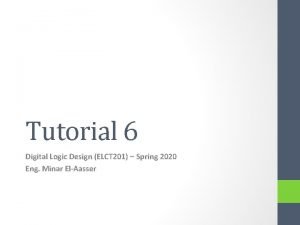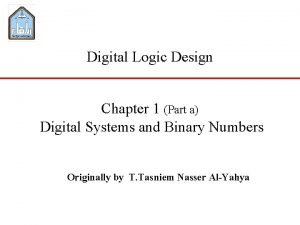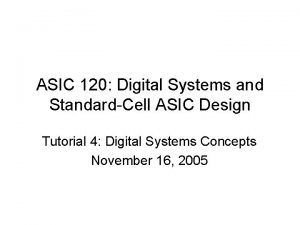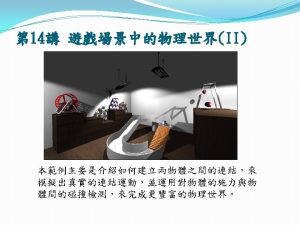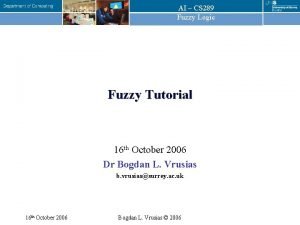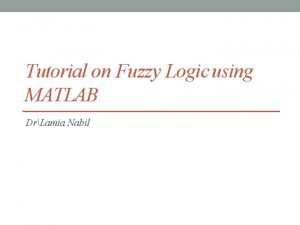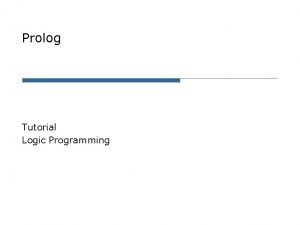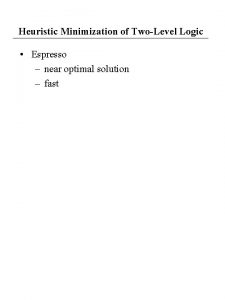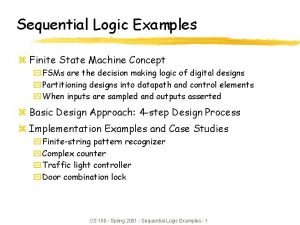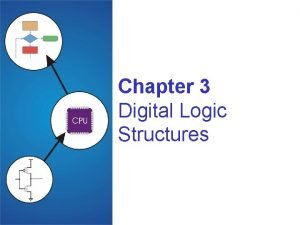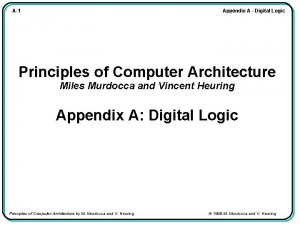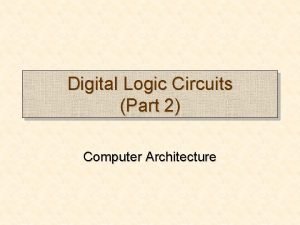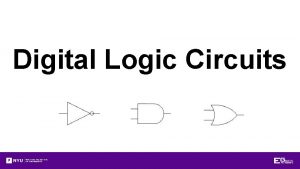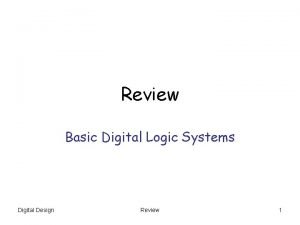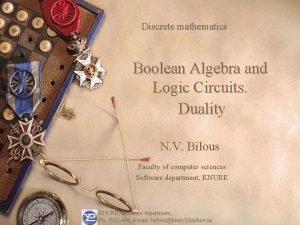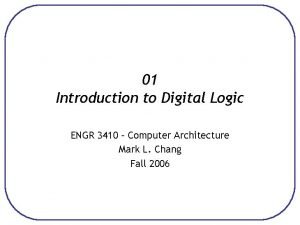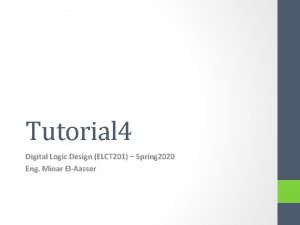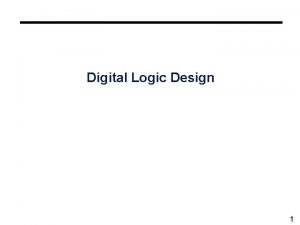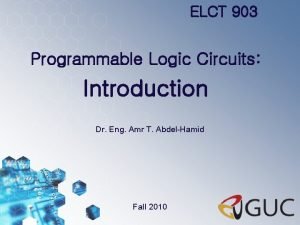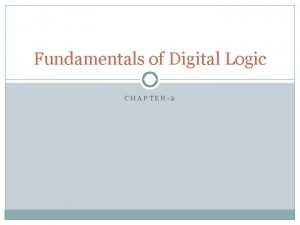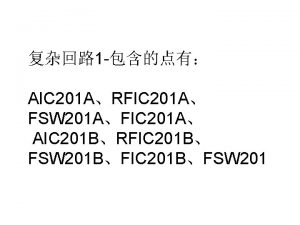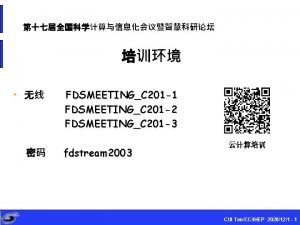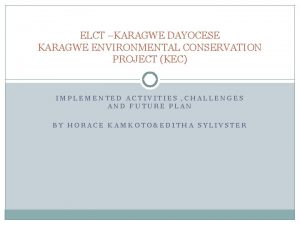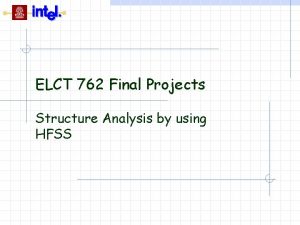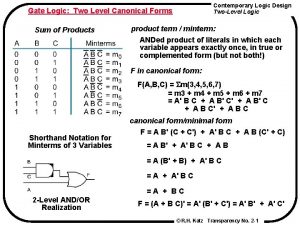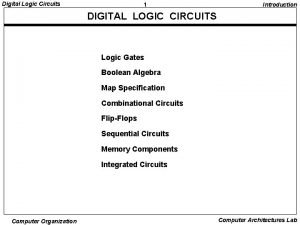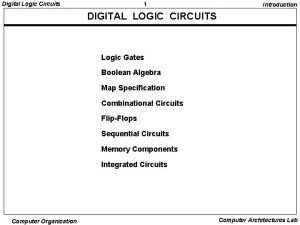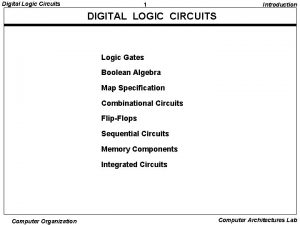Tutorial 6 Digital Logic Design ELCT 201 Spring


![Decoders [n-to-2 n] For each possible i/p combination there are : 2 n – Decoders [n-to-2 n] For each possible i/p combination there are : 2 n –](https://slidetodoc.com/presentation_image_h/7fb9c35d65aaea90d2f33bc80a2963f2/image-3.jpg)
![[n-to-2 n] Decoders n: 2 n decoder 3 -to-8 For. Decoder each possible i/p [n-to-2 n] Decoders n: 2 n decoder 3 -to-8 For. Decoder each possible i/p](https://slidetodoc.com/presentation_image_h/7fb9c35d65aaea90d2f33bc80a2963f2/image-4.jpg)
![n] Decoders [NAND [n-to-2 based] n: 2 n decoder 3 -to-8 Decoder no. of n] Decoders [NAND [n-to-2 based] n: 2 n decoder 3 -to-8 Decoder no. of](https://slidetodoc.com/presentation_image_h/7fb9c35d65aaea90d2f33bc80a2963f2/image-5.jpg)
![n] Decoders [NAND [n-to-2 based] n: 2 n decoder 3 -to-8 Decoder NAND based n] Decoders [NAND [n-to-2 based] n: 2 n decoder 3 -to-8 Decoder NAND based](https://slidetodoc.com/presentation_image_h/7fb9c35d65aaea90d2f33bc80a2963f2/image-6.jpg)
![Decoder [with Enable Line]: [1 st Use: To Control the Circuit Operation] Sheet 6 Decoder [with Enable Line]: [1 st Use: To Control the Circuit Operation] Sheet 6](https://slidetodoc.com/presentation_image_h/7fb9c35d65aaea90d2f33bc80a2963f2/image-7.jpg)
![Decoder [with Enable Line]: 2 graphical representations of NOR: Invert-AND OR-invert [1 st Use: Decoder [with Enable Line]: 2 graphical representations of NOR: Invert-AND OR-invert [1 st Use:](https://slidetodoc.com/presentation_image_h/7fb9c35d65aaea90d2f33bc80a2963f2/image-8.jpg)
![Decoder [with Enable Line]: [1 st Use: To Control the Circuit Operation] Sheet 6 Decoder [with Enable Line]: [1 st Use: To Control the Circuit Operation] Sheet 6](https://slidetodoc.com/presentation_image_h/7fb9c35d65aaea90d2f33bc80a2963f2/image-9.jpg)
![Decoder [with Enable Line]: [1 st Use: To Control the Circuit Operation] no. of Decoder [with Enable Line]: [1 st Use: To Control the Circuit Operation] no. of](https://slidetodoc.com/presentation_image_h/7fb9c35d65aaea90d2f33bc80a2963f2/image-10.jpg)
![Decoder with Enable Line: [2 nd Use: implementing bigger decoders] wxyz 0000 z y Decoder with Enable Line: [2 nd Use: implementing bigger decoders] wxyz 0000 z y](https://slidetodoc.com/presentation_image_h/7fb9c35d65aaea90d2f33bc80a2963f2/image-11.jpg)
![Decoder with Enable Line: [2 nd Use: implementing bigger decoders] wxyz 0000 0 0 Decoder with Enable Line: [2 nd Use: implementing bigger decoders] wxyz 0000 0 0](https://slidetodoc.com/presentation_image_h/7fb9c35d65aaea90d2f33bc80a2963f2/image-12.jpg)
![Decoder with Enable Line: [2 nd Use: implementing bigger decoders] wxyz 1111 1 1 Decoder with Enable Line: [2 nd Use: implementing bigger decoders] wxyz 1111 1 1](https://slidetodoc.com/presentation_image_h/7fb9c35d65aaea90d2f33bc80a2963f2/image-13.jpg)


![Encoders ≠ Decoders [2 n-to-n] Example: 8 -to-3 Encoder n: 2 n decoder 2 Encoders ≠ Decoders [2 n-to-n] Example: 8 -to-3 Encoder n: 2 n decoder 2](https://slidetodoc.com/presentation_image_h/7fb9c35d65aaea90d2f33bc80a2963f2/image-16.jpg)

![Encoders ≠ Decoders [2 n-to-n] Example: 8 -to-3 Encoder D 7 D 6 D Encoders ≠ Decoders [2 n-to-n] Example: 8 -to-3 Encoder D 7 D 6 D](https://slidetodoc.com/presentation_image_h/7fb9c35d65aaea90d2f33bc80a2963f2/image-18.jpg)



![Multiplexer [ 2 n to 1 with n selection lines] 2 n inputs Example: Multiplexer [ 2 n to 1 with n selection lines] 2 n inputs Example:](https://slidetodoc.com/presentation_image_h/7fb9c35d65aaea90d2f33bc80a2963f2/image-22.jpg)
![Multiplexer [ 2 n to 1 with n selection lines] 2 n inputs Example: Multiplexer [ 2 n to 1 with n selection lines] 2 n inputs Example:](https://slidetodoc.com/presentation_image_h/7fb9c35d65aaea90d2f33bc80a2963f2/image-23.jpg)












- Slides: 35

Tutorial 6 Digital Logic Design (ELCT 201) – Spring 2020 Eng. Minar El-Aasser

Agenda • Decoders • Encoders • Multiplexers • Tri-State Buffers
![Decoders nto2 n For each possible ip combination there are 2 n Decoders [n-to-2 n] For each possible i/p combination there are : 2 n –](https://slidetodoc.com/presentation_image_h/7fb9c35d65aaea90d2f33bc80a2963f2/image-3.jpg)
Decoders [n-to-2 n] For each possible i/p combination there are : 2 n – 1 o/p(s) that are equal to 0 and ONLY ONE o/p that is equal to 1 The o/p whose value=1 represents the min-term equivalent to the binary no. presently available in the i/p lines. 3 -to-8 Decoder no. of i/p(s) = 3 no. of o/p(s) = 23 =8 x y z Do D 1 D 2 D 3 D 4 D 5 D 6 D 7 0 0 0 1 0 0 0 0 1 0 0 0 0 1 0 0 0 1 0 0 0 1 1 0 0 0 0 1 1 1 0 0 0 0 1
![nto2 n Decoders n 2 n decoder 3 to8 For Decoder each possible ip [n-to-2 n] Decoders n: 2 n decoder 3 -to-8 For. Decoder each possible i/p](https://slidetodoc.com/presentation_image_h/7fb9c35d65aaea90d2f33bc80a2963f2/image-4.jpg)
[n-to-2 n] Decoders n: 2 n decoder 3 -to-8 For. Decoder each possible i/p combination there are : n o/p(s) that are equalxto 0 yand z 3 =8 no. of i/p(s) = 3 2 – 1 no. of o/p(s) = 2 ONLY ONE o/p that is equal to 1 x y The z o/p Do whose D 1 D 2 value=1 D 3 D 4 represents D 5 D 6 D 7 the min-term equivalent 0 0 to 0 the 1 binary 0 0 no. 0 presently 0 0 available 0 0 in the i/p lines. 0 0 0 1 1 0 1 0 0 3 -to-8 Decoder 1 0 0 0 no. of 1 1 i/p(s) 0 0= 3 0 1 no. 0 of o/p(s) 0 0 0 0 1 1 0 0 x 0 0 0 y 0 0 1 D 0 =0 x’y’z’ 1 D 1 =1 x’y’z 0 D 2 =1 x’yz’ 0 D 3 =1 xy’z’ 1 1 1 z 0 1 0 0 Do D 1 1 0 0 0 1 0 0 D 1 23 =0 =8 0 D 2 D 3 D 4 D 5 D 6 D 7 0 0 0 0 1 0 0 0 1 1 0 0 0 0 0 1 0 0 0 D 04 = xy’z’ 0 0 D 05 = xy’z 0 0 D 06 = xyz’ 0 0 D 07 = xyz 0 0 0 1 1 0 0 D 2 D 3 D 4 D 5 D 6 D 7
![n Decoders NAND nto2 based n 2 n decoder 3 to8 Decoder no of n] Decoders [NAND [n-to-2 based] n: 2 n decoder 3 -to-8 Decoder no. of](https://slidetodoc.com/presentation_image_h/7fb9c35d65aaea90d2f33bc80a2963f2/image-5.jpg)
n] Decoders [NAND [n-to-2 based] n: 2 n decoder 3 -to-8 Decoder no. of i/p(s) = 3 NAND based N. B. : y z Do D 1 D 2 D 3 Decoders 0 constructed 0 0 1 0 with 0 0 0 NAND 0 1 gates 0 1 -> give 0 0 0 decoders 1 0 0 output 0 1 0 (Min-terms) in their 0 1 1 0 0 0 1 complement form 1 0 0 0 “Active Low o/p” 1 0 0 0 0 • Its is used because it 1 0 0 0 is 1 more economical x • 1 1 1 D 0 = x’y’z’ D 1 = x’y’z D 2 = x’yz’ D 3 = xy’z’ 0 x no. of o/p(s) = 23 =8 0 0 0 D 4 = xy’z’ D 5 = xy’z D 6 = xyz’ D 7 = xyz y z D 4 D 5 D 6 D 7 0 0 0 0 D’ x 0 y z Do D 1 D 2 D 3 0 0 0 0 1 0 1 1 0 0 0 0 D ’ 1 0 0 1 0 1 0 0 1 1 0 1 0 1 1 0 0 0 1 D ’ 0 0 0 1 0 1 0 0 0 1 1 0 1 0 1 1 D 4’ 1 0 0 1 1 1 0 1 D 1’ 0 2 3 D 5’ 1 D 0 D 4 D 5 D 6 D 7 D 101 0 1 0 1 D 102 0 1 0 1 D 013 0 1 0 1 0 1 D 104 1 0 0 1 0 1 1 0 D 5 D 6’ D 6 D 7’ D 7
![n Decoders NAND nto2 based n 2 n decoder 3 to8 Decoder NAND based n] Decoders [NAND [n-to-2 based] n: 2 n decoder 3 -to-8 Decoder NAND based](https://slidetodoc.com/presentation_image_h/7fb9c35d65aaea90d2f33bc80a2963f2/image-6.jpg)
n] Decoders [NAND [n-to-2 based] n: 2 n decoder 3 -to-8 Decoder NAND based x y z N. B. : • Decoders constructed with NAND gates -> give decoders output (Min-terms) in their complement form “Active Low o/p” • Its is used because it is more economical DD 0’ x 0 y z Do D 1 D 2 D 3 D 4 D 5 D 6 D 7 0 0 DD 11’ 0 1 0 1 0 1 1 0 0 1 0 1 0 1 0 DD’ 1 0 0 1 0 1 1 1 0 1 0 1 1 0 0 1 0 1 1 DD 3’ 0 0 0 1 0 1 1 1 0 1 0 1 0 1 1 0 0 1 1 0 1 0 1 1 0 0 0 22 3 0 1 DD 44’ 1 1 DD 55’ DD 66’ DD 77’ 1
![Decoder with Enable Line 1 st Use To Control the Circuit Operation Sheet 6 Decoder [with Enable Line]: [1 st Use: To Control the Circuit Operation] Sheet 6](https://slidetodoc.com/presentation_image_h/7fb9c35d65aaea90d2f33bc80a2963f2/image-7.jpg)
Decoder [with Enable Line]: [1 st Use: To Control the Circuit Operation] Sheet 6 – Problem I Design 2 -4 line decoder using NOR gates only (include an enable input) no. of i/p(s) = 3 no. of o/p(s) = 4 E x y Do D 1 D 2 D 3 0 0 0 0 0 1 0 0 0 1 1 0 0 0 1 1 0 1 0 0 1 0 1 1 1 0 0 0 1 E x y Do D 1 D 2 D 3 0 x x 0 0 1 0 1 0 0 1 1 0 0 0 1
![Decoder with Enable Line 2 graphical representations of NOR InvertAND ORinvert 1 st Use Decoder [with Enable Line]: 2 graphical representations of NOR: Invert-AND OR-invert [1 st Use:](https://slidetodoc.com/presentation_image_h/7fb9c35d65aaea90d2f33bc80a2963f2/image-8.jpg)
Decoder [with Enable Line]: 2 graphical representations of NOR: Invert-AND OR-invert [1 st Use: To Control the Circuit Operation] Sheet 6 – Problem I Design 2 -4 line decoder using NOR gates only (include an enable input) no. of i/p(s) = 3 no. of o/p(s) = 4 E x y Do D 1 D 2 D 3 0 0 0 0 0 1 0 0 0 1 1 0 0 0 1 0 1 0 0 1 1 0 0 0 2 = Exy’ 1 1 D 0= 1 Ex’y’ 1 D 1 = Ex’y 0 D D 3 = Exy E x’ x x y Do D 1 D 2 D 3 x x 0 0 0 1 0 1 0 0 1 1 0 0 0 1 0 1 yy’ EE’ D 0 D 1 D 2 D 3
![Decoder with Enable Line 1 st Use To Control the Circuit Operation Sheet 6 Decoder [with Enable Line]: [1 st Use: To Control the Circuit Operation] Sheet 6](https://slidetodoc.com/presentation_image_h/7fb9c35d65aaea90d2f33bc80a2963f2/image-9.jpg)
Decoder [with Enable Line]: [1 st Use: To Control the Circuit Operation] Sheet 6 – Problem I Design 2 -4 line decoder using NOR gates only (include an enable input) no. of i/p(s) = 3 no. of o/p(s) = 4 x’ x E x y Do D 1 D 2 D 3 0 1 x x 0 0 1 0 0 1 0 1 0 0 0 1 0 1 1 0 0 0 1 yy’ D 0 D 1 D 2 EE’ D 3
![Decoder with Enable Line 1 st Use To Control the Circuit Operation no of Decoder [with Enable Line]: [1 st Use: To Control the Circuit Operation] no. of](https://slidetodoc.com/presentation_image_h/7fb9c35d65aaea90d2f33bc80a2963f2/image-10.jpg)
Decoder [with Enable Line]: [1 st Use: To Control the Circuit Operation] no. of i/p(s) = n+1 no. of o/p(s) = 2 n n: 2 n decoder Enable
![Decoder with Enable Line 2 nd Use implementing bigger decoders wxyz 0000 z y Decoder with Enable Line: [2 nd Use: implementing bigger decoders] wxyz 0000 z y](https://slidetodoc.com/presentation_image_h/7fb9c35d65aaea90d2f33bc80a2963f2/image-11.jpg)
Decoder with Enable Line: [2 nd Use: implementing bigger decoders] wxyz 0000 z y x 1111 w 4 to 16 decoder D 0 D 1 D 2 D 3 D 4 D 5 D 6 D 7 01 00 00 D 8 D 9 D 10 D 11 D 12 D 13 D 14 D 15 00 00 10
![Decoder with Enable Line 2 nd Use implementing bigger decoders wxyz 0000 0 0 Decoder with Enable Line: [2 nd Use: implementing bigger decoders] wxyz 0000 0 0](https://slidetodoc.com/presentation_image_h/7fb9c35d65aaea90d2f33bc80a2963f2/image-12.jpg)
Decoder with Enable Line: [2 nd Use: implementing bigger decoders] wxyz 0000 0 0 z y x w 1 E 4 to 16 decoder 0 E D 0 D 1 D 2 D 3 D 4 D 5 D 6 D 7 1 0 0 0 0 D 1 D 2 D 3 D 4 D 5 D 6 D 7 D 8 D 9 D 10 D 11 D 12 D 13 D 14 D 15 0 0 0 0
![Decoder with Enable Line 2 nd Use implementing bigger decoders wxyz 1111 1 1 Decoder with Enable Line: [2 nd Use: implementing bigger decoders] wxyz 1111 1 1](https://slidetodoc.com/presentation_image_h/7fb9c35d65aaea90d2f33bc80a2963f2/image-13.jpg)
Decoder with Enable Line: [2 nd Use: implementing bigger decoders] wxyz 1111 1 1 z y x w 0 E 4 to 16 decoder 1 E D 0 D 1 D 2 D 3 D 4 D 5 D 6 D 7 0 0 0 0 D 0 D 1 D 2 D 3 D 4 D 5 D 6 D 7 D 8 D 9 D 10 D 11 D 12 D 13 D 14 D 15 0 0 0 0 1

Decoders as Multi-purpose Circuit • Decoders provide 2 n midterms of n i/p variables • Any Combinational Circuit with n-inputs and m-outputs can be implemented with an n-to-2 n line decoder & m OR-gates Sheet 6 – Problem II • Design a combinational circuit defined by the following three Boolean functions: 2 graphical representations of NAND: Invert-OR F 1(A, B, C) = ∑(2, 4, 7) AND-invert F 2(A, B, C) = ∑(0, 3) F 3(A, B, C) = ∑(0, 2, 3, 4, 7) Implement the circuit using the decoder constructed with NAND gates and NAND or AND gates connected to the decoder outputs. A F 2 B C NAND based

Decoders as Multi-purpose Circuit Sheet 6 – Problem II • Design a combinational circuit defined by the following three Boolean functions: 2 graphical representations of NAND: F 1(A, B, C) = ∑(2, 4, 7) Invert-OR AND-invert F 2(A, B, C) = ∑(0, 3) F 3(A, B, C) = ∑(0, 2, 3, 4, 7) Implement the circuit using the decoder constructed with NAND gates and NAND or AND gates connected to the decoder outputs. F 2 A F 1 B C NAND based F 3
![Encoders Decoders 2 nton Example 8 to3 Encoder n 2 n decoder 2 Encoders ≠ Decoders [2 n-to-n] Example: 8 -to-3 Encoder n: 2 n decoder 2](https://slidetodoc.com/presentation_image_h/7fb9c35d65aaea90d2f33bc80a2963f2/image-16.jpg)
Encoders ≠ Decoders [2 n-to-n] Example: 8 -to-3 Encoder n: 2 n decoder 2 n : n Encoder

![Encoders Decoders 2 nton Example 8 to3 Encoder D 7 D 6 D Encoders ≠ Decoders [2 n-to-n] Example: 8 -to-3 Encoder D 7 D 6 D](https://slidetodoc.com/presentation_image_h/7fb9c35d65aaea90d2f33bc80a2963f2/image-18.jpg)
Encoders ≠ Decoders [2 n-to-n] Example: 8 -to-3 Encoder D 7 D 6 D 5 D 4 D 3 D 2 D 1 D 0 x y z 0 0 0 0 0 0 1 0 0 0 0 0 1 1 0 0 0 0 0 1 1 1 0 0 ? ? 1 0 0 0 0 0 1 0 1 0 0 0 1 1 0 0 0 0 1 1 1 0 0 Encoder Limitations: 1. An o/p with all 0’s will be generated when all i/ps are zero’s; which is the same o/p as when D 0 = 1 Valid Bit 2. Only 1 i/p can be active at any given time. If 2 i/ps are active simultaneously, the o/p produces an undefined combination Priority Fn.

Priority Encoder with Valid Bit Sheet 6 – Problem VI Design a 4× 2 priority encoder, such that D 3 would have the highest priority. no. of i/p(s) = 4 no. of o/p(s) = 3 D 2 D 1 D 0 x y V 0 0 X X 0 0 1 0 0 1 1 0 0 0 1 0 D 3 D 2 D 1 D 0 x y V 1 0 0 x x 0 1 1 0 0 0 1 1 1 0 0 1 x 0 1 1 1 0 1 0 1 x x 1 0 1 1 x x x 1 1 0 0 0 1 1 1 1 1 0 1 1 1 1 0 0 1 1 1 1 0 1 1 1 1 1 Condensed Form N. B. : • Priority fn. could change! • X’s in i/p useful to represent truth table in its condensed form • X’s in o/p don’t cares

Priority Encoder with Valid Bit Sheet 6 – Problem Design a 4× 2 priority encoder, such that D 3 would have the highest priority. no. of i/p(s) = 4 no. of o/p(s) = 3 D 2 D 1 D 0 x y V 0 0 X X 0 0 1 0 0 1 1 0 1 0 1 1 0 1 0 1 0 1 0 0 0 1 1 0 1 D 3 D 2 D 1 D 0 x y V 0 0 x x 0 0 1 x 0 1 1 1 0 1 x x 1 0 1 1 x x x 1 1 1 0 1 1 1 1 1 0 0 1 1 1 1 0 1 1 1 1 1 Condensed Form N. B. : • Priority fn. could change! • X’s in i/p useful to represent truth table in its condensed form • X’s in o/p don’t cares

Priority Encoder with Valid Bit Sheet 6 – Problem Design a 4× 2 priority encoder, such that D 3 would have the highest priority. D 1 D 0 no. of i/p(s) = 4 no. of o/p(s) = 3 D 1 D 3 D 2 m m 0 X m. D 2 1 m 01 0 0 0 1 x o D 3 0 D 3 V = D 3 + D 2 + D 1 + D 0 D 3 D 2 2 n : n Encoder y V D 1 m 5 D 0 12 13 8 mo m 12 m 8 2 x 1 0 m 10 m 0 11 1 m x 1 m 01 m 7 15 9 11 1 = X m 4 D 3 3 4 D 11 D 0 x x 1 1 1 x D 0 0 x + x. D 1 D x 2 x 3 1 m 3 m 5 m 7 1 m 15 m 13 9 m 11 D 0 y m 6 x m 14 0 m 10 1 1 1 D 1 1 1 V 10 11 D 2 1 m 2 m 6 1 1 yx == D D 3 + D 2 ’ D 1 3 m 14 m 10 1 1 D 2
![Multiplexer 2 n to 1 with n selection lines 2 n inputs Example Multiplexer [ 2 n to 1 with n selection lines] 2 n inputs Example:](https://slidetodoc.com/presentation_image_h/7fb9c35d65aaea90d2f33bc80a2963f2/image-22.jpg)
Multiplexer [ 2 n to 1 with n selection lines] 2 n inputs Example: 2 -to-1 MUX • • 21 inputs Io, I 1 1 inputs Y 1 selection lines S Function Table S Y 0 Io 1 I 1 1 output n selection lines • Truth Table
![Multiplexer 2 n to 1 with n selection lines 2 n inputs Example Multiplexer [ 2 n to 1 with n selection lines] 2 n inputs Example:](https://slidetodoc.com/presentation_image_h/7fb9c35d65aaea90d2f33bc80a2963f2/image-23.jpg)
Multiplexer [ 2 n to 1 with n selection lines] 2 n inputs Example: 2 -to-1 MUX • • 21 inputs Io, I 1 1 inputs Y 1 selection lines S Function Table S Y 0 Io 1 I 1 1 output n selection lines • Truth Table S I 1 o I 0 o Y 0 0 0 1 1 0 0 0 1 1 0 0 1 1 1 S I 1 I 0 0 S 1 I 1 00 01 mo m 1 m 4 m 5 11 m 3 1 m 7 1 1 10 m 2 m 6 I 0 Y = S’I 0 + SI 1 I 0 2: 1 MUX I 1 S y 1

MUX as general purpose logic • 2(x-1) : 1 MUX implements any function of x-variables • X-variables: • 2(x-1) i/p • 1 o/p • X-1 selection lines • Boolean function listed in a truth table: • 1 st (n-1) variables applied as selection lines of the MUX • For each communication of the selection variable (in pairs of 2), we evaluate the o/p as a fn. Of the last variable �could be 0, 1, the variable or its complement

Sheet 6 – Problem III Implement the following expression with a multiplexer only: F 3(A, B, C, D) = ∑(1, 3, 4, 5, 10. 11, 12, 13, 14, 15) S 2 S 1 S 0 A B C D F 0 0 0 0 1 1 1 0 0 1 0 1 1 0 0 0 1 1 1 0 0 0 0 1 0 1 0 1 1 1 1 1 0 1 1 1 I 0=D I 1=D D 1 I 2=1 0 I 3=0 I 4=0 1 I 0 I 1 I 2 I 3 I 4 I 5 I 6 I 7 S 2 MUX as general purpose logic • 2 x-1 : 1 MUX implements any function of x-variables • X-variables: 4 • 2 x-1 i/p 24 -1 = 23=8 • 1 o/p 1 • X-1 selection lines 4 -1 =3 S 1 S 0 I 5=1 I 6=1 I 7=1 A B C • Boolean function listed in a truth table: • 1 st (n-1) variables applied as selection lines of the MUX • For each communication of the selection variable (in pairs of 2), we evaluate the o/p as a fn. Of the last variable could be 0, 1, the variable or its complement

Sheet 6 – Problem III Different Solution Implement the following expression with a multiplexer only: F 3(A, B, C, D) = ∑(1, 3, 4, 5, 10. 11, 12, 13, 14, 15) S 3 S 2 S 1 S 0 A B C D F 0 0 0 0 1 1 1 0 0 1 0 1 1 0 0 0 1 1 1 0 0 0 0 1 0 1 0 1 1 1 1 1 0 1 1 1 Using 16: 1 Mux only I 0 I 1 I 2 I 3 I 4 I 5 I 6 I 7 I 8 I 9 I 10 I 11 I 12 I 13 I 14 I 15 0 1 1 1 0 0 0 1 1 1 I 0 I 1 I 2 I 3 I 4 I 5 I 6 I 7 I 8 I 9 I 10 I 11 I 12 I 13 I 14 I 15 16: 1 Mux A B CD MUX as general purpose logic • 2 x-1 : 1 MUX implements any function of x-variables • X-variables: • • • 2 x-1 i/p 1 o/p X-1 selection lines • Boolean function listed in a truth table: • • 1 st (n-1) variables applied as selection lines of the MUX For each communication of the selection variable (in pairs of 2), we evaluate the o/p as a fn. Of the last variable could be 0, 1, the variable or its complement

Sheet 6 – Problem III Different Solution Implement the following expression with a multiplexer only: F 3(A, B, C, D) = ∑(1, 3, 4, 5, 10, 11, 12, 13, 14, 15) S 1 S 0 A B C D F 0 0 0 0 1 1 1 0 0 1 0 1 0 0 1 1 0 0 0 1 1 1 0 0 0 0 1 0 1 0 1 1 1 1 1 0 1 1 1 Using 4: 1 Mux only MUX as general purpose logic • 2 x-1 : 1 MUX implements any function of x-variables I 0=D D I 0 I 1=C’D’ C I 2 C’ D’ 1 I 2=C I 3=1 • X-variables: • • • I 1 I 3 2 x-1 i/p 1 o/p X-1 selection lines • Boolean function listed in a truth table: • AB • 1 st (n-1) variables applied as selection lines of the MUX For each communication of the selection variable (in pairs of 2), we evaluate the o/p as a fn. Of the last variable could be 0, 1, the variable or its complement

Sheet 6– Problem IV • Implement a full adder using two 4 x 1 multiplexer Full Adder: S 1 S 0 x y z c s 0 0 0 0 1 0 1 0 1 1 1 0 0 0 1 1 0 1 1 1 I 0=0 0 I 0 z I 1 1 C I 2 I 3 I 1=z I 2=z I 3=1 xy I 0 I 1 I 2 I 3

Sheet 6– Problem IV • Implement a full adder using two 4 x 1 multiplexer Full Adder: S 1 S 0 x y z c s 0 0 0 0 1 0 1 0 1 1 1 0 0 0 1 1 0 1 1 1 I 0=z 0 I 0 z I 1 1 C I 2 I 3 I 1=z’ I 2=z’ I 3=z xy z I 0 z' I 1 z S I 2 I 3 xy

Sheet 6 – Problem V • An 8: 1 MUX has inputs A, B and C connected to the selection inputs S 2, S 1 and S 0 respectively. The data inputs I 0 through I 7 are as follows: I 1=I 2=I 7 =0; I 0= I 4=D, I 3=I 5=1 and I 6 = D. Determine the Boolean expression that the multiplexer SA 2 SB 1 SC 0 D F implements 0 0 0 0 1 1 0 0 0 1 0 1 1 0 0 0 1 1 0 1 0 1 1 0 0 1 1 1 1 0 1 1 I 0 I 1 I 2 I 3 I 4 I 5 I 6 I 7

Sheet 6 – Problem V • An 8: 1 MUX has inputs A, B and C connected to the selection inputs S 2, S 1 and S 0 respectively. The data inputs I 0 through I 7 are as follows: I 1=I 2=I 7 =0; I 0= I 4=D, I 3=I 5=1 and I 6 = D. Determine the Boolean expression that the multiplexer SA 2 SB 1 SC 0 D F implements BC C 0 0 0 AB m m 0 0 0 1 1 0 0 0 0 1 1 0 1 1 1 0 0 1 1 1 0 1 1 1 0 0 0 1 1 1 1 1 0 0 1 1 0 I 1 I 2 I 3 I 4 I 5 I 6 I 7 A 1 o 1 m 4 m 5 m 7 m 12 m 13 m 15 m 8 m 9 1 1 3 m 11 D 2 1 m 6 1 m 14 1 m 10 1 F = A’BC + B’C’D + AB’C + ABC’D’ B

Tri-State Buffer 2 i/p(s): a data i/p and a control i/p Enable=1 B=A Enable=0 high impedance

Tri-State Buffer 2 i/p(s): a data i/p and a control i/p Enable=1 B=A Enable=0 high impedance https: //logic. ly/lessons/tri-state-buffer/ Problem VII: Using tri–state buffers and a decoder, design a 4× 1 line multiplexer. 0 0 1 0 0 0

Tri-State Buffer 2 i/p(s): a data i/p and a control i/p Enable=1 B=A Enable=0 high impedance https: //logic. ly/lessons/tri-state-buffer/ Problem VII: Using tri–state buffers and a decoder, design a 4× 1 line multiplexer. 1 1 0 0 0 1

On-Line Challenge Assignment • Design a 3 -input XOR function using MUX only Stay Safe Eng. Minar El-Aasser minar. elaasser@guc. edu. eg
 Digital logic design tutorial
Digital logic design tutorial Digital system design
Digital system design Digital logic design practice problems
Digital logic design practice problems Digital logic design lectures
Digital logic design lectures Digital logic design
Digital logic design Kim ki duk spring summer fall winter
Kim ki duk spring summer fall winter What are the months of spring?
What are the months of spring? Standardcels
Standardcels First order logic vs propositional logic
First order logic vs propositional logic First order logic vs propositional logic
First order logic vs propositional logic Third order logic
Third order logic Combinational logic circuit vs sequential
Combinational logic circuit vs sequential Cryptarithmetic problem logic+logic=prolog
Cryptarithmetic problem logic+logic=prolog Project management plan example
Project management plan example Majority circuit
Majority circuit Combinational logic sequential logic 차이
Combinational logic sequential logic 차이 Logic chapter three
Logic chapter three Unity spring joint
Unity spring joint Cs 289
Cs 289 Tipping problem
Tipping problem Prolog tutorial
Prolog tutorial Only one student failed in mathematics fol
Only one student failed in mathematics fol Espresso logic minimizer tutorial
Espresso logic minimizer tutorial Finite
Finite Inverter timing diagram
Inverter timing diagram Plc mixer process control problem
Plc mixer process control problem Canonical form digital logic
Canonical form digital logic Logic gates identities
Logic gates identities Digital logic structures
Digital logic structures Consensus theorem
Consensus theorem Bubble matching digital logic
Bubble matching digital logic Digital logic and computer architecture
Digital logic and computer architecture Uncommon logic digital
Uncommon logic digital Digital design review
Digital design review Duality law in discrete mathematics
Duality law in discrete mathematics Bubble matching digital logic
Bubble matching digital logic
